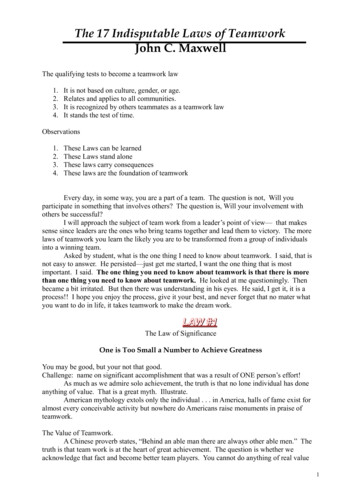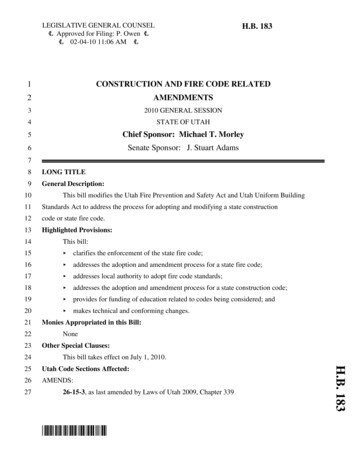
Transcription
The 17 Indisputable Laws of TeamworkJohn C. MaxwellThe qualifying tests to become a teamwork law1.2.3.4.It is not based on culture, gender, or age.Relates and applies to all communities.It is recognized by others teammates as a teamwork lawIt stands the test of time.Observations1.2.3.4.These Laws can be learnedThese Laws stand aloneThese laws carry consequencesThese laws are the foundation of teamworkEvery day, in some way, you are a part of a team. The question is not, Will youparticipate in something that involves others? The question is, Will your involvement withothers be successful?I will approach the subject of team work from a leader’s point of view— that makessense since leaders are the ones who bring teams together and lead them to victory. The morelaws of teamwork you learn the likely you are to be transformed from a group of individualsinto a winning team.Asked by student, what is the one thing I need to know about teamwork. I said, that isnot easy to answer. He persisted—just get me started, I want the one thing that is mostimportant. I said. The one thing you need to know about teamwork is that there is morethan one thing you need to know about teamwork. He looked at me questioningly. Thenbecame a bit irritated. But then there was understanding in his eyes. He said, I get it, it is aprocess!! I hope you enjoy the process, give it your best, and never forget that no mater whatyou want to do in life, it takes teamwork to make the dream work.LAW #1The Law of SignificanceOne is Too Small a Number to Achieve GreatnessYou may be good, but your not that good.Challenge: name on significant accomplishment that was a result of ONE person’s effort!As much as we admire solo achievement, the truth is that no lone individual has doneanything of value. That is a great myth. Illustrate.American mythology extols only the individual . . . in America, halls of fame exist foralmost every conceivable activity but nowhere do Americans raise monuments in praise ofteamwork.The Value of Teamwork.A Chinese proverb states, “Behind an able man there are always other able men.” Thetruth is that team work is at the heart of great achievement. The question is whether weacknowledge that fact and become better team players. You cannot do anything of real value1
alone. That is the Law of Significance. I challenge you to think of one act of genuinesignificance in the history of humankind that was performed by a lone human being. There noproblems that we cannot solve together, and very few that we can solve by ourselves. Teams involve more people, thus affording more resources, ideas, and energy thanwould an individual.Teams maximize a leader’s potential and minimize her weaknesses. Strengths andweaknesses are more exposed in individuals.Teams provide multiple perspectives on how to meet a need or reach a goal, thusdevising several alternatives for each situation. Individual insight is seldom as broadand deep as a group’s when it takes on a problem.Teams share the credit for victories and the blame for losses. This fosters genuinehumility and authentic community. Individuals take credit and blame alone. Thisfosters pride and sometimes a sense of failure.Teams keep leaders accountable for the goal. Individuals connected to no one canchange the goal without accountability.Teams can simply do more than an individual.If you want to reach your potential or strive for the seemingly impossible, you needto become a team player. Individuals play the game, but teams win the championship.Why Do we Stand Alone?1. Ego. Teamwork is birthed when you concentrate on “we” instead of “me.” It marks abig step in your development when you come to realize that other people can help youdo a better job than you could do alone.2. Insecurity. Some people fail to promote teamwork because they feel threatened byother people. This goes along with the Law of Empowerment. Insecure leaders usuallyfail to build teams because of one of two reasons: Either they want to maintain controlover everything for which they are responsible, or they fear being replaced by someonemore capable. We should not only use all the brains we have, but all that we can borrow.3. Naivete. Some people aren’t very outgoing and simply don’t think in terms of teambuilding and team participation. Why take the journey alone when you can take othersalong. If you do everything alone and never partner with other people, you create hugebarriers to your own potential.What are the major goals you are working toward achieving right now?Now, reflect on how you are working toward these goals. What approach have you been takingto achieve them? Are you going it alone: Or are you building a team to accomplish them?If your not trying to be a part of a team, figure out why.Becoming a Better Team LeaderThink about the greatest dream you have for your life. Now ask yourself,1. Is it bigger than I am?2. Does it benefit others as well as myself?3. Is it worth dedicating part of my life to?If you answer is yes to all of these questions, then think about what kinds of peopleshould join you to achieve that dream. Make a list of the like-minded people youknow who might want to join you in the process. Then invite them to take the journeywith you.2
LAW # 2The Law of the Big PictureThe Goal is more important than the role.What is in it for me?I saw a message on a T-shirt that expresses the attitude well: “My idea of a team is awhole lot of people doing what I tell them to do.A team isn’t supposed to be a bunch of people being used as a tool by one individual forselfish gain. Members of a team have mutually beneficial shared goals. Anyone who isaccustomed to pulling together people and using them to benefit only himself isn’t a teambuilder; he is a dictator.If you think you are the entire picture, you will never see the big picture.It’s all About the TeamIf a team is to reach its potential, each player must be willing to subordinate his personalgoals to the good of the team. They are willing to sacrifice their role for the greater gain.That’s the Law of the Big Picture.Seeing The Big PicturePeople who build successful teams never forget that every person on a team has a role to play,and every role plays its part in contributing to the bigger picture. Without this perspective ateam cannot accomplish a goal.Leaders at the highest level understand the Law of the Big Picture. They continuallykeep the vision of the big picture before themselves and their people.It takes courage and resolve to recognize that the goal is more important than the role. Itis no small thing for people do wi what’s best for the team.What’s Up With the Big PictureSo how do people start to become a more unified team? How do individuals make theshift from independent people to team players who exemplify the Law of the Big Picture? Ittakes time. Here is my best take on how to get the process started.1. Look Up at the Big Picture. Everything starts with vision. You need to have a goal.Without one you cannot have a real team. If you don’t know where you’re going, you’llend up somewhere else. An individual without a goal may end up anywhere. A group ofindividuals without a goal can go nowhere. On the other hand, if everyone in a groupembraces the vision for achieving the big picture, then the people have the potential tobecome an effective team. Leaders usually have the role of capturing andcommunicating vision. If you are the leader of your team, your role is to do what onlyyou can do: Paint the big picture for your people. Without the vision they will not findthe desire to achieve the goal2. Size up the Situation. One value of seeing the big picture is that it helps you recognizehow far you really are from achieving it. To make it to the next level we need a fewmore people like the ones we already have. That is the mindset of a team-builder.3. Line Up Needed Resources. You cannot make progress without the support of theappropriate equipment, facilities, funds, and so forth—whether your goal is climbing amountain, capturing a market, or creating a ministry. The better resourced the team is,the fewer distractions the players will have as they try to achieve their goal.3
4. Call Up the Right Players. If you don’t have the right players, you are not going to getanywhere. (I will talk more about this in several other laws.) You can lose with goodplayers, but you cannot win with bad ones.5. Give Up Personal agendas. Teams that win have players who continually askthemselves, What is the best for the rest? They continually set aside their personalagendas for the good of the team. The motto needs to be, no one is more important thanthe rest of us.6. Step Up to a Higher Level. Only when players come together and give up their ownagendas can a team move up to a higher lever. That’s the kind of sacrifice required forteamwork. Philosopher Fredrich Nietzche said: “many are stubborn in pursuit of thepath they have chosen, few in pursuit of the goal.”Becoming a Better Team MemberWhat goal in your life is bigger than you are? Are you currently participating insomething greater than yourself. If your trying to accomplish something big, then ask yourselfwhat you are willing to do to accomplish it. Are you willing to take a subordinate role ifnecessary for the good of the team.Becoming a Better Team LeaderThink about a team you are currently part of (preferably one with a big goal). What kind of attitude do team members have when it comes to the big picture? Are they team players who desire to do whatever it takes for the team to succeed? Or do they desire to benefit only themselves?Begin to foster a team mindedness in others by modeling a willingness to serve the bigpicture rather than yourself. Then think about ways you can help your teammates to embracethe Law of the Big Picture. Motivate people by painting the big picture. Publicly honor teamplay. And give rewards to people who sacrifice for the good of the team.LAW # 3The Law of the NicheAll Players Have Place Where They Add the Most ValueAll players have a place where they add the most value to a team. When you have the rightteam member in the right place, everyone benefits.Good things happen to a team when a player takes the place where he adds the mostvalue. Great things happen when all the players on the team take the role that maximizes theirstrengths—their talent, skill, and experience. That’s the power of the Law of the Niche.When People are In the Wrong PlaceWhat happens to a team when one or more of its members constantly play out ofposition? First, morale erodes because the team isn’t playing up to its capability. Then peoplebecome resentful. The people working in an area of weakness resent that their best is untapped.And other people on the team who know that they could better fill a mismatched position on theteam resent that their skills are being overlooked. Before long, people are unwilling to work asa team. When people aren’t where they do things well, things don’t turn out will. That’s the4
Law of the Niche.The wrong person in the wrong place RegressionThe wrong person in the right place FrustrationThe right person in the wrong place ConfusionThe right person in the right place ProgressionThe right people in the right places MultiplicationAll players have a place where they add the most value. When each person does the job that’sbest for him, everybody wins.Put People in their Place.You may have a group of talented individuals, but if each person is not doing what adds themost value to the team, you won’t achieve your potential as a team. That’s the are of leading ateam. You’ve got to put people in their places—and I mean that in the most positive way! Tobe able to put people in their places that utilize their talents and maximize the team’s potential,you need three things:1. You must know the team. You cannot build a winning team or organization if you don’tknow its vision, purpose, culture, or history.2. You Must Know the Situation. Good team builders know where the team is and what thesituation requires. For example, when a team is young and just getting started, the greatestpriority is often to gather good people. But as the team matures and the level of talentincreases, fine-tuning becomes more important. At that time aleader must spend more timematching the person to the position.3. You Must Know the Player. It sounds obvious, but you must know that person you aretrying to position in the right niche.As you work to build a team, evaluate each person’s experience, skills, temperament, attitude,passions, people skills, discipline, emotional strength, and potential. Only then will you beready to help a team member find his proper place.Start by Finding the Right Place for You.If you thinking, How do I find my niche? Follow these guidelines.Be Secure.Get to Know yourself. You can’t find your niche if you don’t know your personalweaknesses and strengths. Spend time reflecting on and exploring your gifts. Askothers to give you feedback. Do what it takes to remove personal blind spots. Trust your leader. A good leader will help you start moving in the right direction. Ifyou don’t trust your leader, look to another mentor for help. Or, get on another team. See the big picture. Your place on the team makes sense only in the context of the bigpicture. Rely on your experience. When it comes down to it, the only way to know that you’vediscovered your niche is to try what seem right and learn from your failures andsuccesses. When you discover what you were made for, your heart sings.Becoming a Better Team MemberIf you know what your niche is but aren’t working in it, start planning a transition. It could beas simple as a change in duties or as complex as a change of career. No mater whether it willrequire six weeks or six years, you need a transition plan and a time table for completing it.Once you’re certain of your course, have the courage to take the first step. To help people reachtheir potential and maximize their effectiveness, stretch them out of their comfort zones, butnever out of their gift zones. 5
LAW #4The Law of Mount EverestAs the challenge escalates, the need for teamwork elevates.Illustrate climbing MT. Everest. For each level that the climbers reached, a higher degree ofteamwork was required.What is your Everest?I bet you have a dream. I say that with confidence because deep down everybody has one—even the people who haven’t figured out what theirs is yet. If you have a dream, you need adream team to accomplish it. How do you approach the task of putting together a team toaccomplish your dream: I think the best way to start is to ask yourself three questions.1. What is My Dream? Nothing much happens without a dream. For something reallygreat to happen, it takes a really great dream.” I you want to do something great, youmust have a dream. But a dream is not enough. You can fulfill a dream only if you arepart of a team. NASA- put a man on the moon- the dream of J.F. Kenedy2. Who is on My team? The second question tell s you what it. It measures your currentsituation. Your potential is only as good as your current team. That’s why you mustexamine who is joining you on your journey. A great dream with a bad team is nothingmore than a nightmare.3. What Should My Dream Team Look Like? The truth is that your team must be thesize of your dream.Focus on the Team, Not the Dream.One mistake I’ve seen people repeatedly make is that they focus too much attention on theirdream and too little on their team. But the truth is that if you build the right team, the dreamwill almost take care of itself.TYPE OF CHALLENGETYPE OF TEAM REQUIREDNew ChallengeControversial ChallengeChanging challengeUnpleasant ChallengeDiversified ChallengeLong-term ChallengeEverest-sized ChallengeCreative TeamUnited TeamFast and Flexible TeamMotivated TeamComplementary TeamDetermined TeamExperienced TeamIf you want to achieve your dreams—I mean really do it, not just imagine what it would be like—then grow your team. But as you do make sure your motives are right. Some people gather ateam just to benefit themselves. Others do it because they enjoy the team experience and whatto create a sense of community. Still others do it because they want to build an organization.The funny thing about these reasons is that if you’re motivated by all of them, then your desireto build a team probably comes from wanting to add value to everyone on the team. But if yourdesire to build a team comes as a result of only one of these reasons, you probably need toexamine your motives.6
How To Grow A TeamWhen a team you have doesn’t match up to the team of your dreams, then you have only twochoices: Give up your dream, or grow up your team. Here is my recommendation concerninghow to do the latter.1. Develop Team Members: The first step to take with a team that’s not realizing itspotential is to help individual team members to grow. If you’re leading the team, thenone of your most important responsibilities is to see the potential that people don’t see inthemselves and draw it out. When you accomplish this, you’re doing your job as aleader.Think about the people on your team, and determine what they need based on thefollowing categories: Enthusiastic beginner—needs direction Disillusioned learner—needs coaching Cautious completer—needs support Self-reliant achiever—needs responsibility2. Add Key Team Members. Even if you give every person on your team a chance tolearn and grow, and all of them make the most of the opportunities, you may find thatyou still lack the talent needed to accomplish your dream. That’s when it’s time torecruit that talent.3. Change the Leadership. Various team challenges require different kinds of leadership.If a team has the right talent but still isn’t growing, sometimes the best thing you can dois to ask someone from the team who has previously been a follower to step into aleadership role. The challenge of the moment often determines the leader for thatchallenge. If you team is facing a big challenge, and it doesn’t seem to be making anyprogress then it might be time to change the leaders.4. Remove the Ineffective Members. Sometimes a team member can turn a winningteam into a losing one, either through lack of skill or a poor attitude. Growing a team isdemanding and time-consuming. But if you want to achieve your dream, you have noother choice. The greater the dream, the greater the team. As the challenge escalates,the need for teamwork elevates. That is the Law of Mount Everest.Becoming a Better Team MemberWhat is your natural first reaction when a challenge becomes more difficult? Do you go offalone to think? Do you try to solve the problem alone? Do you stay away from other people toavoid the pressure? Or do you lean on your teammates and let them lean on you?If you don’t do it , teach yourself to rally with your teammates. You cannot win a greatchallenge alone.Becoming a Better Team LeaderWhat kinds of adjustments do you need to make to create your dream team, one that can meetthe challenges ahead? Do you need to spend more time developing your people? Do you needto add key team members? Or should you make changes to the leadership? And don’t forgetthat you, too, need to keep growing. What’s true for a teammate is also true for the leader: Ifyou don’t grow, you gotta go.7
LAW #5The Law of the ChainThe Strength of a Team is Impacted by Its Weakest LinkAs much as any team likes to measure itself by its best people, the truth is that the strength ofthe team is impacted by its weakest link. No matter how much people try to rationalize it,compensate for it, or hide it, a weak link will eventually come to light. That’s the Law of theChain.Your Team Is Not For EveryoneOne of the mistakes I often made early in my career as a team leader was that I thoughteveryone who was on my team should remain on the team. Just Because I wanted too takeeveryone with me didn’t mean that it would always work out that way.1. Not Everyone Will Take the Journey. Some people don’t want to go. For otherpeople the issue is their attitude. They don’t want to change, grow, or conquer newterritory. All you can do with people in this group is kindly thank them for their pastcontributions and move on.2. Not Everyone Should Take the Journey. Other people shouldn’t join a team becauseit’s a matter of their agenda. The best thing you can do for people in this category iswish them well, and as far as you are able, help them on their way so that they achievesuccess n their venture.3. Not Everyone Can Take the Journey. For this group of people, the issue is ability.They may not be capable of keeping pace with their teammates or helping the group getwhere it wants to go. They can’t keep pace with other team members.They don’t grow in their area of responsibility.They don’t see the big picture.They won’t work on personal weakness.They won’t work with the rest of the team.They can’t fulfill expectations for their area.If you have people who display one or more of those characteristics, then you need toacknowledge that they are weak links. They are not necessarily bad people.What can you do with people on your team who are weak links? You really have only twochoices: You need to train them or trade them. Of course, your first priority should always beto try to train people who are having a hard time keeping up. People often rise to your level ofexpectation. Give them hope and training, and they usually improve.But what should you do it a team member continually fails to meet expectations, even afterreceiving training, encouragement, and opportunities to grow? My father used to have a saying:Water seeks its own level. Somebody who is weak on your team might be capable of becominga star on another team. You need to give that person an opportunity to find his level somewhereelse.8
Several things may happen when a weak link remains on the team.1. The Stronger Members identify the Weak One. A weak link cannot hide (except in agroup of weak people).2. The Stronger Members Have to Help the Weak One. If your people must worktogether as a team to do their work, then they have only two choices when it comes to aweak teammate. They can ignore the person and allow the team to suffer, or they canhelp him and make the team more successful. If they are team players they will help.3. The Stronger Members Come to Resent the Weak One. Whether strong teammembers help or not, the result will always be the same: resentment. No one like tolose or fall behind consistently because of the same person.4. The Stronger Members Become Less Effective. Carrying someone else’s load inaddition to your own compromises you performance. Do that for a long time, and thewhole team suffers.5. The Stronger Members Question the Leader’s Ability. Anytime the leader allows aweak link to remain a part of the team, the team members forced to compensate for theweak person begin to doubt the leader’s courage and discernment. One of thedifferences between leaders and followers is action.Strengthening the ChainWeak team members always take more to the team’s time than strong ones. For example, if yourate people on a scale of 1 to 10 (with 10 being the best), a 5 among 10’s really hurts the team,where an 8 among 10’s often does not.Let me show you how this works. When you first put together a group of people their talentscome together in a way that is analogous to addition. So visually a 5 among 10’s looks like this10 10 10 10 5 45The difference between this team and great ones with five 10’s is like the difference between 50and 45. That’s the difference of 10%. Once a team comes together and starts to developchemistry, synergy, and momentum, it’s analogous to multiplication. That’s when a weak linkreally starts to hurt the team. It’s the difference between this:10 X 10X 10 X 10 X10X 100,00010 X 10 X 10 X 10 X 5 50,000That is a difference of 50 percent! The power and momentum of the team may be able tocompensate for a weak link for a while, but not forever. A weak link eventually robs the teamof momentum—and potential.Ironically, weak links are less aware than stronger members of their weaknesses andshortcomings. If you need to remove somebody from the team, be discreet, be clear, be honest,and be brief. Then once the person is gone, be open about it with the rest of the team whilemaintaining respect for the person you let go.Becoming a Better Team MemberMost people’s natural inclination is to judge themselves according to their best qualities whilethey measure others by their worst. As a result, they point to areas there their teammates needto grow. But the truth is that every person is responsible for his growth first.9
Evaluated bySelf FriendPossible Issues Have trouble keeping pace with other team members. Am not growing in my area of responsibility. Have a hard time seeing the big picture. Have a tough time working with the rest of the team. Consistently fail to fulfill expectations in area of responsibility.If you (or the other person who evaluated you) checked more than one box you need to putyourself on a growth plan so that you don’t hinder your team. Talk to your team leader or atrusted mentor about ways you can grow in any weak area.Becoming A Better Team LeaderIf the team is a ministry and training has made no impact, then it might be appropriate to ask theweak people to sit on the sidelines for a while.No matter what kind of situation you face, remember than your responsibilities to people comein the following order: to the organization, to the team, and then to the individual. Your owninterests—and comfort—come last.LAW # 6The Law of the CatalystWinning Teams Have Players who Make Things HappenMost teams don’t naturally get better on their own. A team that reaches its potential alwayspossesses a catalyst.Definition of a CatalystCatalysts are what I call get it done and then some people. Winning teams have players whomade things happen. That is the law of the catalyst. Every Catalyst brings intensity to the table.Three Kinds of PlayersWhen crunch time comes, a catalyst becomes critical, whether it’s the salesperson who hits theimpossible goal, the ballplayer who makes the big play, or the parent who gets a child to believein himself at a critical moment in life. A team can’t reach big goals or even break new ground ifit doesn’t have a catalyst. When the clock is running down and the game is on the line, there arereally only three kinds of people on a team1. People who don’t want the ball. Some people don’t have the ability to come throughfor the team in high-pressure situations, and they know it. As a result, they don’t wantthe responsibility.10
2. People who want the ball but shouldn’t have it. These are people who cant carry theteam to victory. The problem is they don’t know they can’t. These people aredangerous to a team.3. People who want the ball an should have it. The smallest group are the go to playersat crunch time and who can actually deliver.Every team needs catalysts if it wants to go to the highest level.Characteristics of a CatalystHow do you recognize a catalyst before the fact? How do you look for catalysts on your currentteam.1. Intuitive. Catalysts sense things that others don’t sense. They are able to use whateverthey sense to help the team. The catalyst may be a person who intuitively recognizesleadership and can recruit talented volunteers. A catalyst senses an opportunity, and as aresult, the team benefits. (Barnabus).2. Communicative. Catalysts say things that other team members don’t say in order to getthe team moving.3. Passionate. Catalysts feel thing that others don’t feel. They are passionate about whatthey do, and they want to share that love with their teammates. However it comes out, itcan inspire a team to success.4. Talented. Catalysts are capable of doing what others cannot do because their talent is asstrong as their passion. People rarely become catalysts outside their area of expertiseand gifting. You can’t take a team to the next level if you have not mastered the skills ittakes to succeed on a personal level. You can’t do that if you have no credibility withthem because of your own poor performance.5. Creative. They think things that others do not think. They are constantly looking forfresh innovative ways to do things.6. Initiating. My experience with creative people has taught me something about them.While all creative people have more than enough ideas, not all of them are good atimplementing those creative thoughts. Catalysts don’t have this problem. They dothings that others cannot do. Not only are they creative in their thinking, but they aredisciplined in their actions. They delight in making things happen. So they initiate.And as a result they move the team as they move themselves.7. Responsible. If it is up to be, it’s up to me. That could very well be the motto for allcatalysts. Catalysts are not consultants. They don’t recommend a course of action.They take responsibility for making it happen.8. Generous. Catalysts give things that others don’t give. A true mark of the people’staking responsibility is their willingness to give of themselves to carry somethingthrough.9. Influential. Catalysts are able to lead teammates in a way that others cannot. Teammembers will follow a catalyst when they won’t respond to anyone else.11
When you see many of those nine qualities in someone on your team, then take heart. Whencrunch time comes, he is likely to step up to a whole new level of performance and attempt totake the team there too.If you see someone with that potential in some of your current teammates, encourage themto take initiative and become positive influencers on the team. If people won’t step up then startrecruiting people who will. No team can go to the highest level without a catalyst.LAW #7The Law of the CompassVision gives team members direction and confi
John C. Maxwell The qualifying tests to become a teamwork law 1. It is not based on culture, gender, or age. 2. Relates and applies to all communities. 3. It is recognized by others teammates as a teamwork law 4. It stands the test of time. Observations 1. These Laws can be learned 2. These Laws stand alone 3. These laws carry consequences 4.










